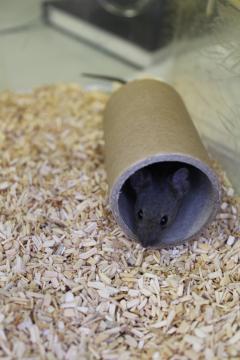Biosecurity & Health Screening
Information on unit health status, maintenance of the barrier and observing the 48 hour period of quarantine.
Health status
BVS is committed to setting quality standards in animal care and to assuring that these standards are maintained throughout all of our colonies, which are to be maintained at the highest possible health status. The BVS Animal Health Program, developed with advice from VSS, closely monitors importation of new animals and colony health status by means of screening contact sentinels and random colony animals.
We observe the guidelines set out by Federation for Laboratory Animal Science Associations (FELASA), our core aims are:
- Assure the health and well-being of our animal colonies by routine and extensive monitoring for undesirable infectious agents.
- Prevent the entry of infectious agents by rederivation and strict health monitoring of all incoming animals.
- Minimize the opportunity for transmission of infectious agents between cages through the extended use of isolator and IVC caging and adherence to rigorous animal health practices.
The 48 hour rule
To limit cross-contamination between Biomedical Research Facilities (BRF) staff and researchers/users, access to units in different zones (see below) are not permitted on any one working day. The only exception to this is the Aquatics facility at the QMRI.
A 48 hour period of quarantine must be observed before visiting a second BRF zone.
This is a mandatory rule that forms part of the Code of Practice, deliberate breach will result in access to BVS facilities being revoked.
Maintenance of the barrier

Procedures to maintain the barrier, are the responsibility of all staff and users of BVS faclilities, including the sanitation or sterilization of all supplies and equipment entering the barrier.
Animal stocks are bred and maintained in Biomedical Research Facilities (BRF) located across the university. These vary in design and style of barrier provided. Therefore, close observation of the local entry procedures given in the Code of Practice and local entry signage for each particular Unit is essential. If you are unsure of the procedure for a particular area, please contact (secured)the relevant unit manager, prior to entry.
All staff/researchers/users are required to, either,
- change/remove their outside clothing and sanitize their hands or,
- shower (including hair)
Upon entry, laundered unit clothing will be available, including shoes, plus an additional requirement (check local entry signage) to wear, eg, mob caps, disposable gloves, respiratory protective equipment.
Access to all animal rooms is limited to personnel who have a work assignment in that room.
Research staff should pay particular attention to the barrier when designing experiments and conducting procedures. Aseptic technique is to be observed at all times. Where it is necessary to introduce a biological material into a living animal consideration must be given the source and pathogen status of the biological material. The Unit Manager must be informed of all new proposed work.
Screening of cell lines and tissues for rodent pathogens
Before cell lines or tissues are introduced into live rodents, the potential risks of introduction of rodent pathogens must be considered. Contamination may derive from the original source of the cells, subsequent passage in rodents, or co-culture with primary culture cells prepared from rodents.
Consistent with the Codes of Practice for rodent units within The University of Edinburgh, cell lines and tissues that have not previously been tested for rodent pathogens must be screened before inoculation or transplantation into recipient rodents.
For further information regarding unit health status or screening, please contact the relevant unit manager or NACWO. (secured)

